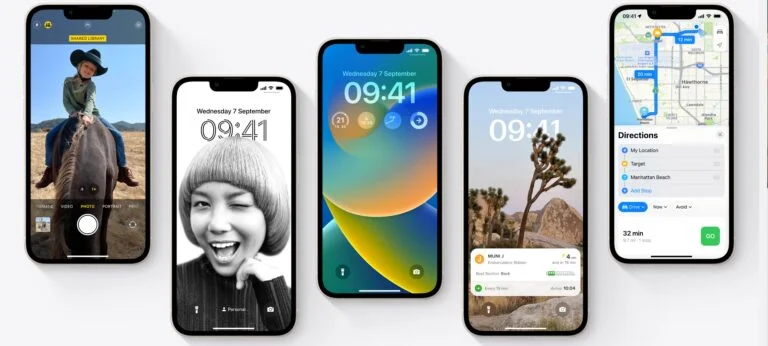
Apple has provided a sneak peek into the upcoming iOS 17, revealing a range of impressive accessibility features for iPhone, iPad, and Mac users. These exciting additions are set to launch later this year and will greatly benefit individuals with cognitive, speech, and vision challenges. The new software features, including iOS 17, iPadOS 17, and macOS 14, are expected to be showcased at WWDC in early June, with an anticipated release date in the fall.
One of the standout features is Assistive Access, which simplifies the user experience by streamlining core app features on iPhones and iPads. This mode combines essential functionalities into a single Calls app, including Phone and FaceTime, along with other commonly used apps like Messages, Camera, Photos, and Music. Assistive Access offers a user-friendly interface with high contrast buttons, large text labels, and customizable options. Users can choose between a visually appealing grid-based layout or a text-based row layout for their Home Screen and apps.
Another noteworthy addition is Live Speech, which allows users to type their desired messages and have them spoken out loud during phone calls, FaceTime conversations, and in-person interactions. Additionally, users can save frequently used phrases for quick access. For individuals who may face challenges in speaking, such as those with amyotrophic lateral sclerosis (ALS), Personal Voice offers a remarkable solution. By recording 15 minutes of audio through randomized text prompts on an iPhone or iPad, users can create a digital voice that closely resembles their own. This feature employs on-device machine learning to ensure privacy and integrates seamlessly with Live Speech functionality.
The Magnifier app introduces the innovative Point and Speak feature, which assists users in interacting with physical objects containing multiple text labels. For instance, while using household appliances, Point and Speak combines the capabilities of the Camera app, LiDAR Scanner, and on-device machine learning to announce text labels as users move their fingers across the keypad. This functionality is part of the Magnifier app on iOS 17-supported devices and works harmoniously with VoiceOver, People Detection, Door Detection, and Image Descriptions, making it easier for users to navigate their surroundings effectively.
Aside from these exciting features, Apple has included other enhancements to address specific accessibility needs. Deaf or hard-of-hearing users can now directly pair Made for iPhone hearing devices with Macs, offering customization options tailored to their requirements. Voice Control gains phonetic suggestions for text editing, aiding users who prefer voice typing and require accurate word choices. The Voice Control Guide provides helpful tips and tricks for utilizing voice commands as an alternative to touch and typing. Additionally, Switch Control allows any switch to function as a virtual video game controller, expanding accessibility for users with limited mobility.

iOS 17 also brings improvements to text size adjustments across various Mac apps, including Finder, Messages, Mail, Calendar, and Notes. Users who are sensitive to rapid animations can now choose to automatically pause images with moving elements, like GIFs, in Messages and Safari. Furthermore, Siri’s speaking speed can be customized, with options ranging from 0.8x to 2x, allowing users to personalize their experience based on their preferences.
With the introduction of iOS 17, Apple is making significant strides in accessibility, empowering individuals with diverse needs to fully embrace the digital world. As we eagerly await the official release, expected in the fall, Apple enthusiasts can anticipate experiencing these remarkable accessibility features on supported iOS 17 devices. Stay updated with the latest news on iOS 17 supported devices, iOS 17 sideloading, and the highly anticipated iOS 17 release date.
In terms of iOS 17 supported devices, Apple aims to provide these accessibility features across a wide range of iPhones, iPads, and Macs. While specific details regarding the compatibility of iOS 17 with different devices have yet to be announced, Apple typically ensures broad device support for its software updates. Users can expect iOS 17 to be available on recent iPhone models, including the iPhone 12, iPhone 11, iPhone SE (2nd generation), and possibly older models as well. Similarly, iPads such as the iPad Pro, iPad Air, iPad (8th generation), and potentially earlier versions are likely to receive iOS 17 compatibility.
When it comes to iOS 17 sideloading, Apple has not provided any official information regarding the ability to sideload applications or modify the system beyond the official App Store. Historically, Apple has maintained a strict approach to app distribution, emphasizing security and user experience. While sideloading may be a popular topic among some users, it is important to note that Apple’s ecosystem has been designed to prioritize safety and stability. As such, any potential changes to sideloading capabilities would be subject to Apple’s discretion and policies.
As for the iOS 17 release date, Apple typically unveils its major software updates at the Worldwide Developers Conference (WWDC) in early June. During this event, developers and enthusiasts get a sneak peek into the upcoming features and enhancements. Following the WWDC preview, Apple usually releases the finalized version of iOS, including iOS 17, to the public in the fall. However, it is worth noting that exact release dates may vary, and Apple will provide more specific information closer to the official launch.
In conclusion, iOS 17 is set to revolutionize accessibility on Apple devices, introducing a range of features designed to empower users with cognitive, speech, and vision challenges. While specific device compatibility and sideloading capabilities are yet to be confirmed, Apple is expected to provide broad support for iOS 17 across a range of iPhones, iPads, and Macs. Stay tuned for further announcements regarding iOS 17 supported devices, sideloading options, and the official release date. These advancements showcase Apple’s dedication to inclusivity and its ongoing commitment to making technology accessible for everyone.

